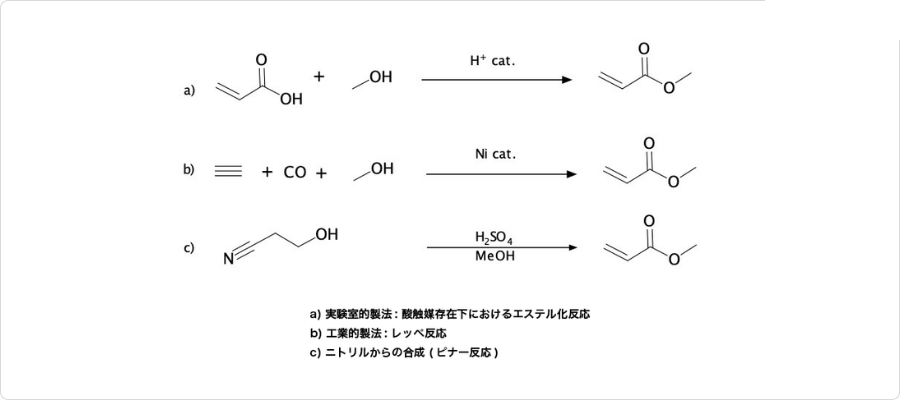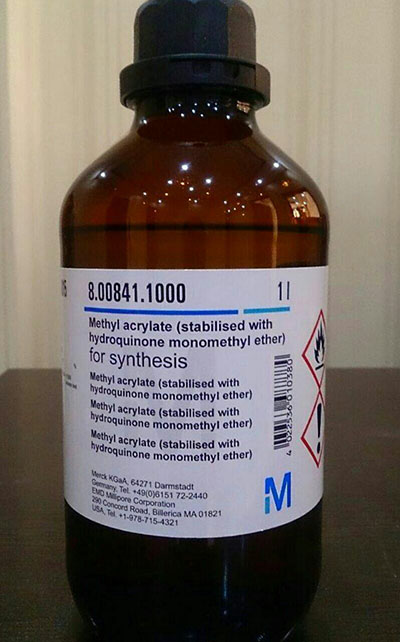アクリル酸メチル 化学特性,用途語,生産方法
外観
無色澄明の液体
種類
製品としてのアクリル酸メチルには、試薬用途としての小型製品や産業用の大型容量製品等の種類があります。化学試薬としての小型製品の容量は、1mL, 10mL, 25mL, 50mL, 100mLから、500mL, 1L, 2.5L程度までです。
通常、 重合防止剤として、ヒドロキノンモノメチルエーテルが約100〜300 ppm含まれます。産業用の大型製品には、15kg缶、180kgドラム缶、ローリー等の荷姿があります。
溶解性
水に可溶 (6g/100ml水, 20℃)。アルコール, アセトンと混和。
解説
アクリル酸メチル (Methyl Acrylate) とは、アクリル酸エステルの一種である有機化合物です。
MAと省略形で表記されることもあります。IUPAC命名法では、プロペン酸メチル (methyl propenoate) と呼ばれます。
二重結合を有するエステル化合物で、分子式はCH2=CHCOOCH3です。自然界の果実などの匂いに近い、エステル臭と呼ばれる強い匂いのする無色透明の液体です。揮発性かつ引火性物質として、危険物第4類第1石油類非水溶性液体に指定されています。
用途
アクリル酸メチルはアクリル酸とメタノールをエステル化した製品です。
アクリル酸メチルはアクリル繊維、成型用樹脂、粘接着剤、塗料、エマルション(エマルジョン)、繊維処理剤、塗料などの原料として使用されます。
用途
アクリル繊維樹脂副原料,成形樹脂共重合用,塗料用アクリル樹脂原料,粘?接着剤用アクリル樹 脂原料,汚泥処理用凝集剤原料;ポリアクリル酸メチル(アクリル樹脂)原料,塗料用樹脂?表面加工用樹脂原料
合成

図2. アクリル酸メチルの合成方法
アクリル酸エステルは、オレフィン部分がエステル基の電子求引性によって活性化されており、求核剤と容易に反応可能です。また、自己重合を起こしやすいため、一般的には安定剤としてヒドロキノンモノメチルエーテルが添加されます。
アクリル酸メチルは、、系のエステルの中でも特に重合しやすい物質です。尚、不純物としてやプロピオン酸メチルが含まれることがあります。
主な用途/役割
アクリル樹脂原料、反応性アクリル樹脂系接着剤に使用される。
説明
Methyl acrylate is an organic compound with the formula CH
2CHCO
2CH
3. It is the methyl ester of acrylic acid. It is a colourless liquid with a characteristic acrid odor. It is mainly produced to make acrylate fiber, which is used to weave synthetic carpets. It is also a reagent in the synthesis of various pharmaceutical intermediates.
化学的特性
Methyl acrylate is a clear, colorless, corrosive liquid with a sharp, fruity odor. It is soluble in water and completely miscible with most organic solvents.

Methyl acrylate has a variety of industrial uses. the more important commercial uses of methyl acrylate include the preparation of thermoplastic coatings, use in the manufacture of acrylic and modacrylic fibers. In the fiber application, methyl acrylate is used as a comonomer with acrylonitrile. These acrylic fibers usually contain about 85% acrylonitrile and are used to fabricate clothing, blankets, carpets, and curtains. Other uses of methyl acrylate include coatings, adhesives, textile backcoatings, elastomers, plastics, and it is also found in ionic exchange resins, barrier film resins, antioxidant intermediates and acrylic fibers.
物理的性質
Clear, colorless, flammable liquid with a heavy, sweet, pungent odor. An odor threshold
concentration of 3.5 ppb
v was reported by Nagata and Takeuchi (1990).
使用
Methyl acrylate is a monomer used in the manufacture of acrylic fibers, plastic films, textiles, papercoatings, and other acrylate ester resins. It is also used in amphoteric surfactants.
製造方法
Acrylate esters can be produced in a number of ways. The most commonly used method, developed in 1970, involves a propylene oxidation process. The reaction occurs initially with the oxidation of propylene to acrolein, which in turn is oxidized to acrylic acid. Once the acrylic acid is formed, it is reacted with methanol which causes the formation of the methyl acrylate. This reaction is shown as follows:

An older method, the Reppe process, involves reacting acetylene with nickel carbonyl and methyl alcohol in the presence of an acid to produce methyl acrylate.
More recent methods for producing acrylate esters involve the use of organic carbonates as esterifying agents or isolating 2-halo- 1-alkenes from hydrocarbon feedstocks to produce the acrylate esters (Haggin, 1985).
調製方法
Methyl acrylate is manufactured via a reaction of nickel
carbonyl and acetylene with methanol in the presence of
an acid; more commonly, however, it is manufactured
via oxidation of propylene to acrolein and then to
acrylic acid. The acid is reacted with methanol to yield
the ester.
定義
methacrylate: A salt or ester ofmethacrylic acid (2-methylpropenoicacid).
一般的な説明
Colorless volatile liquid with an acrid odor. Flash point 27°F. Vapors may irritate the eyes and respiratory system. Highly toxic by inhalation, ingestion and skin absorption. Less dense than water (0.957 gm / cm3) and slightly soluble in water, hence floats on water. Vapors heavier than air.
空気と水の反応
Highly flammable. Forms peroxides when exposed to air that may initiate spontaneous, exothermic polymerization. Peroxide formation usually proceeds slowly. Slightly soluble in water.
反応プロフィール
METHYL ACRYLATE ignites readily when exposed to heat, flame or sparks. Offers a dangerous fire and explosion hazard. Reacts vigorously with strong oxidizing materials. Forms peroxides when exposed to air that may initiate spontaneous exothermic polymerization. Peroxide formation usually proceeds slowly. Added inhibitor retards polymerization. If the inhibitor is consumed during long storage, explosive polymerization may occur [MCA Case History No. 2033]. Also subject to strongly exothermic polymerization if heated for prolonged periods or contaminated.
危険性
Flammable, dangerous fire and explosion
risk. Toxic by inhalation, ingestion, and skin absorption; irritant to skin, eyes and upper respiratory tract
irritant; eye damage. Questionable carcinogen.
健康ハザード
The liquid is a strong irritant, and prolongedcontact with the eyes or skin may causesevere damage. Inhalation of its vapors cancause lacrimation, irritation of respiratorytract, lethargy, and at high concentrations,convulsions. One-hour exposure to a concen tration of 700–750 ppm in air caused deathto rabbits. The oral toxicity of methyl acry late in animals varied from low to moderate,depending on species, the LD50 values ranging between 250 and 850 mg/kg. The liquidmay be absorbed through the skin, producingmild toxic effects.
火災危険
Flammable liquid; flash point (closed cup)
-4°C (25°F), (open cup) -3°C (27°F); vapor
pressure 68 torr at 20°C (68°F); vapor density
3.0 (air = 1); the vapor is heavier than air and
can travel a considerable distance to a source
of ignition and flashback; autoignition tem perature not established; fire-extinguishing
agent: dry chemical, CO2, or “alcohol” foam;
use water to keep the fire-exposed containers
cool and to flush or dilute any spill; the vapors
may polymerize and block the vents.
The vapors of methyl acrylate form explo sive mixtures with air, over a relatively wide
range; the LEL and UEL values are 2.8 and
25.0% by volume in air, respectively. Methyl
acrylate undergoes self-polymerization at
25°C (77°F). The polymerization reaction
proceeds with evolution of heat and the
increased pressure can cause rupture of
closed containers. The reaction rate is accelerated by heat, light, or peroxides. Vigorous
to violent reaction may occur when mixed
with strong oxidizers (especially nitrates and
peroxides) and strong alkalie.
性质
アクリル酸メチルは、分子式CH2=CHCOOCH3で表される、分子量86.1、融点-76.5℃、沸点80.3℃、引火点-2.8℃の化合物です。常温では無色透明の液体であり、密度は0.953〜0.959g/mL (20℃)、水に溶ける性質を示します (6g/100ml水, 20℃) 。CAS登録番号は、96-33-3です。
使用用途
アクリル酸メチルは、各種化学反応の反応剤として汎用性の高い化合物です。そのため、他のアクリル酸エステル一般と同様に、広範な産業分野で製品原料として活用されています。
主な用途は、アクリル繊維、成型用樹脂、粘接着剤、塗料、エマルジョン、繊維処理剤、塗料等の原料です。また、他の樹脂の共重合原料などにも用いられます。
具体的な産業分野の例としては、自動車業界 (各種部品や成型用樹脂) 、皮革加工や紙加工、アクリルゴムの製造等が挙げられます。
また、アクリル酸メチルは、や粘着剤として透明性や耐熱性、耐溶剤性などにおいて優位です。そのため、液晶パネルやスマートフォンなどの保護シートなどへも応用されています。
安全性情報
アクリル酸メチルの蒸気と空気の混合気体は引火すると爆発を起こす危険性があるため、注意が必要です。アクリル酸メチル自体も引火性があります。
また、人体への有害性では下記をはじめとする様々な危険性が指摘されています。
- 重篤な皮膚の薬傷及び眼の損傷
- 重篤な眼の損傷
- 吸入すると有毒
- 発がんのおそれ
- 呼吸器の障害
- 水生生物に毒性
取り扱いの際は、保護メガネや保護手袋などの保護具が必須です。各種法令では、下記の内容が定められています。
- 消防法: 第4類引火性液体、第一石油類非水溶性液体
- 労働安全衛生法: 危険物・引火性の物、健康障害防止指針公表物質、名称等を表示すべき危険物及び有害物、名称等を通知すべき危険物及び有害物、危険性又は有害性等を調査すべき物、作業場内表示義務
- 化学物質排出把握管理促進法 (PRTR法): 第1種指定化学物質
安全性プロファイル
Poison by ingestion and
intraperitoneal routes. Moderately toxic by
skin contact. Mddly toxic by inhalation.
Human systemic effects by inhalation:
olfaction effects, eye effects, and respiratory effects. A skin and eye irritant. Mutation
data reported. Chronic exposure has
produced injury to lungs, liver, and kidneys
in experimental animals. Questionable
carcinogen. Dangerously flammable when
exposed to heat, flame, or oxidzers.
Dangerous explosion hazard in the form of
vapor when exposed to heat, sparks, or
flame. Can react vigorously with oxidzing
materials. A storage hazard; it forms
peroxides, which may initiate exothermic
polymerization. To fight fire, use foam,
COa, dry chemical. When heated to
decomposition it emits acrid smoke and
irritating fumes. See also ESTERS.
安全性
It is an acute toxin with an LD
50 (rats, oral) of 300 mg/kg and a TLV of 10 ppm.
職業ばく露
Methyl acrylate is used in production
of acrylates, copolymers, barrier resins; and surfactants for
shampoos; as a monomer in the manufacture of polymers
for plastic films, textiles, paper, and leather coating
resins. It is also used as a pesticide intermediate and in
pharmaceutical manufacture.
発がん性
Methyl acrylate was not shown to be carcinogenic in male and female rats in a lifetime inhalation study. Not listed by ACGIH, California Proposition 65, IARC, NTP, or OSHA.
環境運命予測
Photolytic. Polymerizes on standing and is accelerated by heat, light, and peroxides (Windholz
et al., 1983). Methyl acrylate reacts with OH radicals in the atmosphere (296 K) and aqueous
solution at rates of 3.04 x 10
-12 and 2.80 x 10
-12 cm
3/molecule?sec, respectively (Wallington et al.,
1988b).
Chemical/Physical. Begins to polymerize at 80.2 °C (Weast, 1986). Slowly hydrolyzes in water
forming methyl alcohol and acrylic acid (Morrison and Boyd, 1971). Based on a hydrolysis rate
constant of 0.0779/M?h at pH 9 at 25 °C, an estimated half-life of 2.8 yr at pH 7 was reported
(Roy, 1972). The reported rate constant for the reaction of methacrylonitrile with ozone in the gas
phase is 2.91 x 10
-18 cm
3 mol/sec (Munshi et al., 1989a).
貯蔵
Methyl acrylate is stored in a flammable materials storage room or cabinet below 20°C (68°F), separated from oxidizing substances. It is inhibited with 200 ppm ofhydroquinone monomethyl ether to preventself-polymerization. It is shipped in bottles,cans, drums, or tank cars.
輸送方法
UN1919 Methyl acrylate, stabilized, Hazard
Class: 3; Labels: 3-Flammable liquid.
純化方法
Wash the ester repeatedly with aqueous NaOH until free from inhibitors (such as hydroquinone), then wash it with distilled water, dry (CaCl2) and fractionally distil it under reduced pressure in an all-glass apparatus. Seal it under nitrogen and store it at 0o in the dark. [Bamford & Han J Chem Soc, Faraday Trans 1 78 855 1982, Beilstein 2 IV 1457.]
不和合性
Forms explosive mixture in air.
Incompatible with nitrates, oxidizers, such as peroxides,
strong alkalis. Polymerizes easily from heat, light, peroxides; usually contains an inhibitor, such as hydroquinone.
廃棄物の処理
Dissolve or mix the material
with a combustible solvent and burn in a chemical incinerator equipped with an afterburner and scrubber. All federal,
state, and local environmental regulations must be
observed. Consult with environmental regulatory agencies
for guidance on acceptable disposal practices. Generators
of waste containing this contaminant (≥100 kg/mo) must conform to EPA regulations governing storage, transportation, treatment, and waste disposal
アクリル酸メチル 上流と下流の製品情報
原材料
準備製品